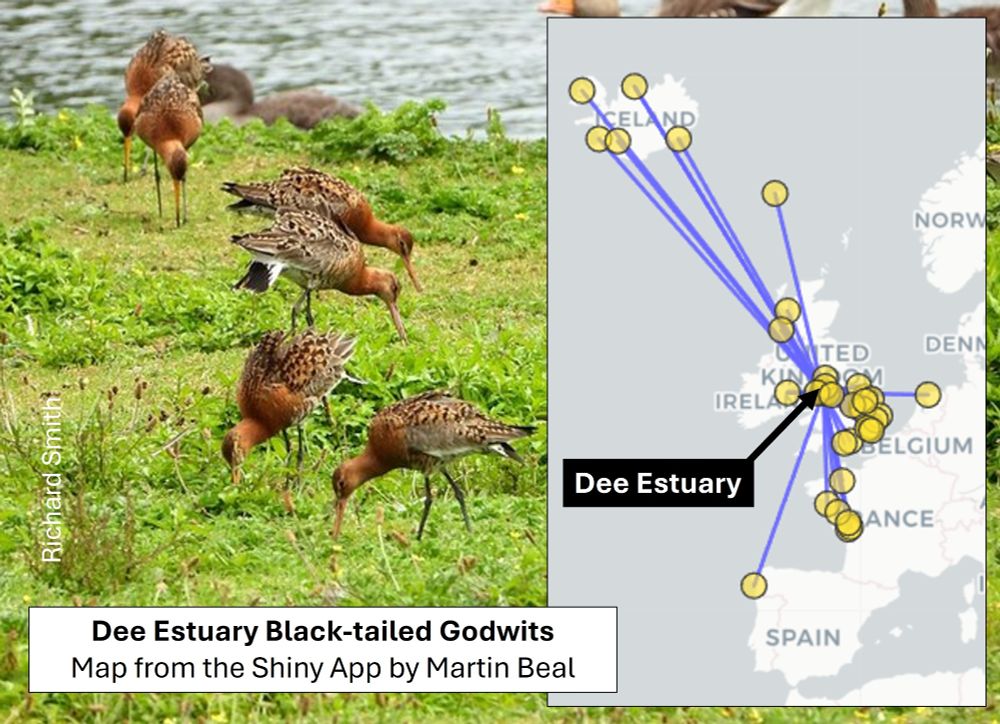
We publish Waterbirds: The International Journal of Waterbird Biology
🦢 https://bioone.org/journals/waterbirds 🪿

Les Cater shares his story and stunning photos of these rare birds ⤵️

Les Cater shares his story and stunning photos of these rare birds ⤵️
Here's how the Dee Estuary links to other sites.
Draw your local map using a ShinyApp:
wadertales.wordpress.com/2025/01/09/h...
#ornithology

Here's how the Dee Estuary links to other sites.
Draw your local map using a ShinyApp:
wadertales.wordpress.com/2025/01/09/h...
#ornithology

➡️ vist.ly/4bz8w
#ornithology #birds #climate 🪶



➡️ vist.ly/4bz8w
#ornithology #birds #climate 🪶
Balancing the trade-offs between conservation and restoration in woodland creation and wader protection
Details here: iapetus.ac.uk/studentships...
@chrissuthy.bsky.social
@ps-wildlife-res.bsky.social
@naturescot.bsky.social
@rspbscience.bsky.social
📷Ben Andrew

Balancing the trade-offs between conservation and restoration in woodland creation and wader protection
Details here: iapetus.ac.uk/studentships...
@chrissuthy.bsky.social
@ps-wildlife-res.bsky.social
@naturescot.bsky.social
@rspbscience.bsky.social
📷Ben Andrew


Estudiamos el #paíño de Madeira, un #avemarina amenazada que cría en #Canarias. Esta población reproductora en invierno es clave para entender su #ecología.
Nuestro equipo de la UB ha colocado #GPS para conocer sus movimientos.
Los datos ayudarán a delimitar #KBAs.




We're seeking an Editor-in-Chief for our journal, Waterbirds. The EIC is responsible for professional services in editing &
publication of the Society’s journal ornithologyexchange.org/jobs/board/n... Please share! Questions: managingeditor@waterbirds.org

We're seeking an Editor-in-Chief for our journal, Waterbirds. The EIC is responsible for professional services in editing &
publication of the Society’s journal ornithologyexchange.org/jobs/board/n... Please share! Questions: managingeditor@waterbirds.org
This summer a team from the RSPB travelled to North Rona – an uninhabited island about 44 miles north of Lewis – to survey one of Scotland’s most incredible birds: Leach’s Storm Petrel. 🌊
www.youtube.com/watch?v=lEQm...

This summer a team from the RSPB travelled to North Rona – an uninhabited island about 44 miles north of Lewis – to survey one of Scotland’s most incredible birds: Leach’s Storm Petrel. 🌊
www.youtube.com/watch?v=lEQm...
#seabirds #OpenAccess #HeatWaves
www.marineornithology.org/PDF/53_2/53_...

#seabirds #OpenAccess #HeatWaves
www.marineornithology.org/PDF/53_2/53_...
We are recruiting for 5 roles:
Secretary 👩🏫
Assistant Journal Editor 📉
Social Media Lead 🤳
Assistant Newsletter/ Social Media Support 🤝
Website Officer 🧑💻
Feel free to DM for details & email secretary@seabirdgroup.org.uk to apply (deadline 31 Oct) 📥

We are recruiting for 5 roles:
Secretary 👩🏫
Assistant Journal Editor 📉
Social Media Lead 🤳
Assistant Newsletter/ Social Media Support 🤝
Website Officer 🧑💻
Feel free to DM for details & email secretary@seabirdgroup.org.uk to apply (deadline 31 Oct) 📥
You have until October 31st to submit your breeding seabird data to the SMP so that it can be utilised in understanding how species have faired this year! #seabirds @btobirds.bsky.social @jncc.bsky.social @rspb.bsky.social

You have until October 31st to submit your breeding seabird data to the SMP so that it can be utilised in understanding how species have faired this year! #seabirds @btobirds.bsky.social @jncc.bsky.social @rspb.bsky.social

After the outbreak: how gannets bounce back from bird flu
bou.org.uk/blog-lewi...
Based on this IBIS paper doi.org/10.1111/ibi....
#ornithology 🪶

After the outbreak: how gannets bounce back from bird flu
bou.org.uk/blog-lewi...
Based on this IBIS paper doi.org/10.1111/ibi....
#ornithology 🪶

📷: Stephan Sprinz

📷: Stephan Sprinz
Check it all in our new paper @waterbirdsociety.bsky.social
doi.org/10.1675/063....
@teresacatry.bsky.social @marescience.bsky.social @cienciasulisboa.bsky.social

Check it all in our new paper @waterbirdsociety.bsky.social
doi.org/10.1675/063....
@teresacatry.bsky.social @marescience.bsky.social @cienciasulisboa.bsky.social



www.marineornithology.org/PDF/53_2/53_...
#seabirds #OpenAccess

www.marineornithology.org/PDF/53_2/53_...
#seabirds #OpenAccess

